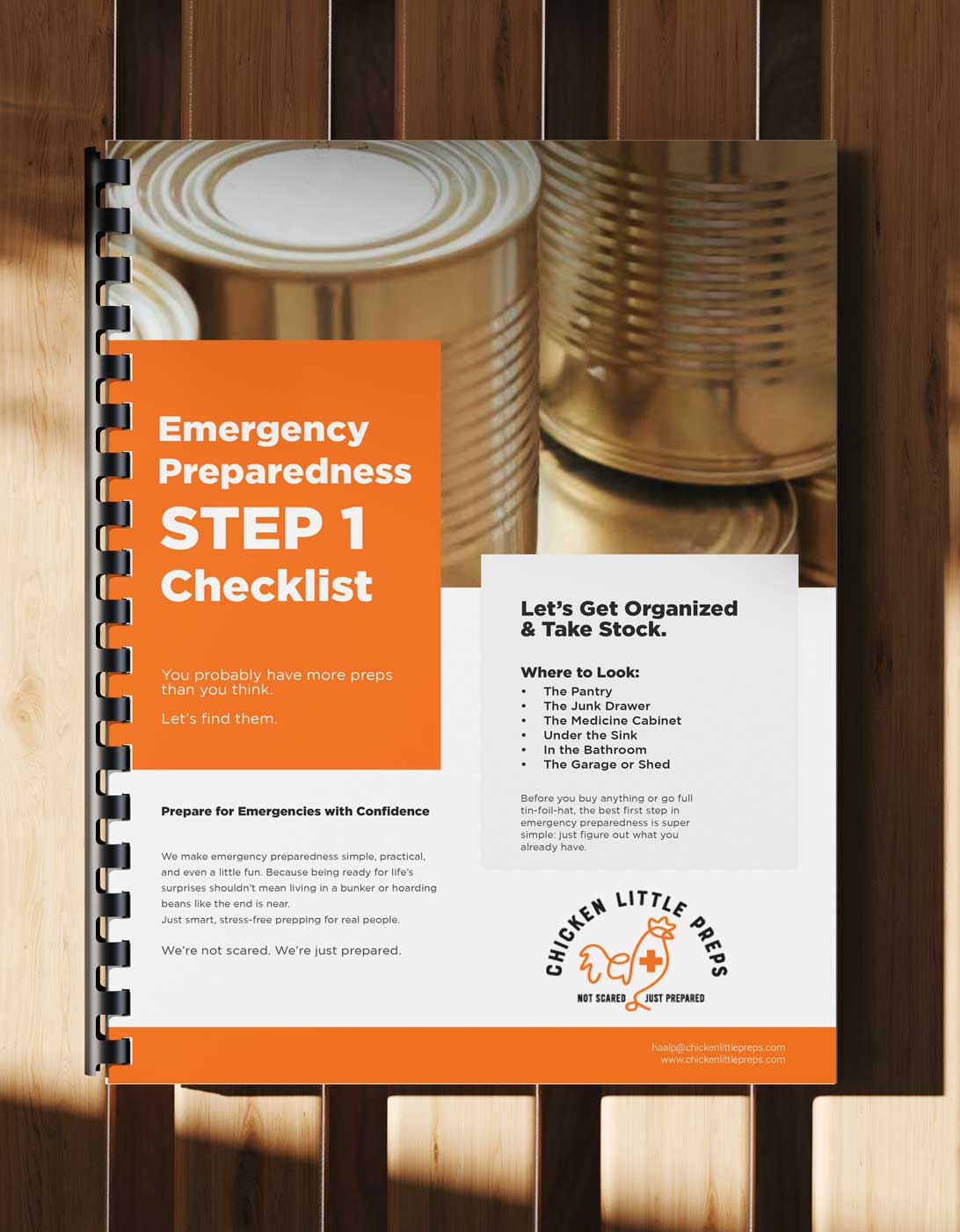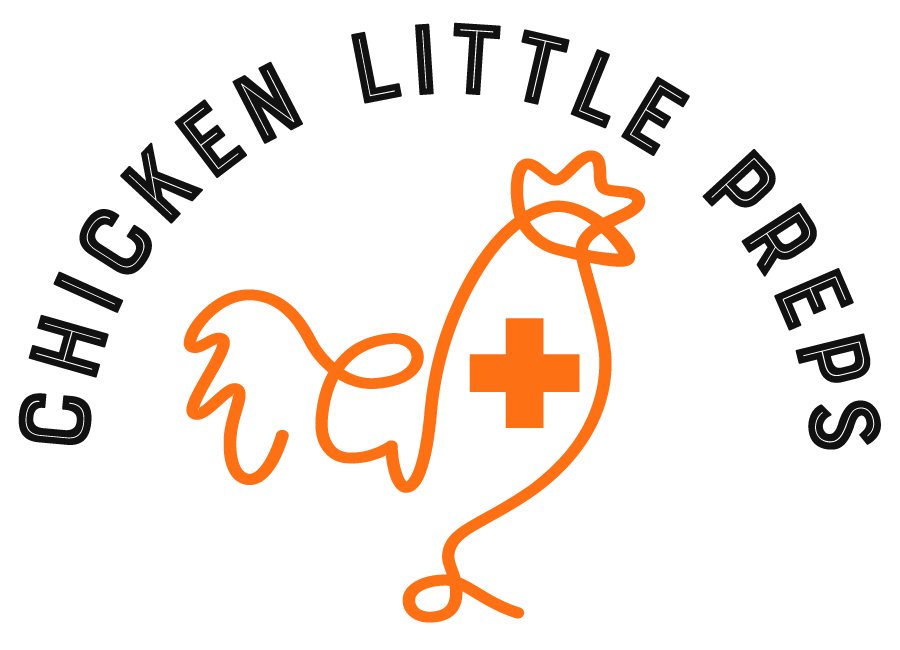Emergency Preparedness Step 3
Build a 72-Hour Food & Water SupplyBecause the worst time to shop is when everyone else is panicking.

Build a 72-Hour Food & Water Supply
You’ve taken stock. You’ve got a plan. Now let’s fill in the most essential part of your prep: food and water.
The goal? Make sure everyone in your household can eat, drink, and stay (relatively) comfortable for at least 72 hours without power, running water, or access to the grocery store.
This isn’t about MRE bricks or five-gallon buckets of mystery stew. It’s about real food your family actually likes—and water stored smartly—so you can weather the unexpected with confidence and snacks.
Why This Step Matters
Most everyday disruptions—storms, power outages, road closures, even supply chain hiccups—last a few hours to a few days. That means a 3-day supply of food and water is the perfect first goal.
It’s the difference between stressing and sipping tea when the lights go out.
Heads up! Some links in this post are affiliate links, which means we may earn a small commission if you buy something—at no extra cost to you. It helps keep the lights on (literally, in case of a power outage) and most importantly helps us spread the word that prepping can be simple and fun! Thank you for supporting our mission here at Chicken Little Preps.
What to Include in Your 72-Hour Food Supply
Choose shelf-stable, easy-to-eat foods:
-
Canned soups, stews, chili, beans (check out these shelf-stable meal kit recipes for convenience)
-
Boxed or pouch meals (mac & cheese, rice kits, pasta)
-
Peanut butter, crackers, granola bars, trail mix
-
Shelf-stable milk or plant-based alternatives
-
Canned fruit and veggies
-
Instant oatmeal or cereal
-
Comfort food: chocolate, coffee, tea
Cluck-Worthy Tip: Choose foods that don’t require a fridge or freezer and that your family will actually eat. Our Grid-down Recipes are a great resource to try if you want handy shelf-stable meals ready to go.
Don’t Forget a Way to Cook
If the power’s out, you’ll need a backup cooking method:
-
Large camp stove or small depending on your needs (don’t forget fuel)
- Portable power station and an electric hot plate
-
Sterno cans + folding stove rack
-
Camping oven or grill (with extra charcoal or propane)
-
Fire pit (if local laws allow)
- A solar oven or thermal bag for a passive cooking option to save fuel
Safety Tips!
- Store fuel safely
- Practice using your gear before you need it
- Don’t cook, even with electric which can spark, if you suspect a gas leak. Be sure to store a few preps that don’t require cooking.
How Much Water Do You Need?
The absolute minimum should include 1 gallon of water per person per day (but 2 gallons would be a lot more comfortable). This includes drinking, cooking, and basic hygiene.
So for 3 days:
-
1 person = 3 gallons
-
4 people = 12 gallons
-
Don’t forget pets! 🐶🐱
Water Storage Ideas:
-
Pre-bottled water (cheap, easy, ready to go)
-
Shelves to stack 5-gallon water bottles, and manual water pump for easy use without power
-
Water container with a spigot for convenient hand and dish washing
-
Bathtub water bladder (extra emergency water for incoming storms)
- Water treatment drops for stored water
- A gravity-fed water filter can help provide clean drinking water for everyday use
Cooking & Cleaning Essentials
-
Prep & Serve Gear:
Manual can opener, pot or pan, heat-safe utensils, paper plates, bowls, cups, plastic cutlery -
Cleanup Supplies:
Dish soap, sponge or scrub brush, paper towels, napkins, trash bags (kitchen + heavy-duty)
Store It Where It Makes Sense
Keep your 72-hour supply somewhere easy to access in a pinch:
-
Store in clear plastic bins with lids in a hall closet or spare room
- Store potatoes and onions in breathable, light-proof containers
-
On a garage shelf (only items that aren’t temperature sensitive)
-
Under the bed in storage bins
-
Dedicated “emergency shelf” in your pantry
Label it, check expiration dates a few times year, and rotate as needed.
Make a Simple Inventory
Keep it casual: just jot down what you have, what you need, and maybe a few “nice-to-haves” for later. You can use:
-
A notes app on your phone
-
A spreadsheet (if you’re fancy)
-
A notebook, clipboard, or printable Chicken Little checklist

Final Thought
Building your 72-hour food and water supply is like packing a weekend bag for your house. It’s basic, it’s comforting, and it means you’re not relying on last-minute grocery runs when the shelves are bare. Bonus: it also comes with snacks.
Next Up: Step 4 – Build a 14-Day Food & Water Supply
Now that you’ve covered a long weekend, let’s stretch your prep into two weeks—without sacrificing taste, sanity, or coffee.
Starting a new habit is tough—but staying prepared doesn’t have to be.
Join a community that shares your goals, because together, we can prep for life - not just the next crisis. Subscribe to our email list for friendly reminders, smart tips, and friendly prepping advice.
